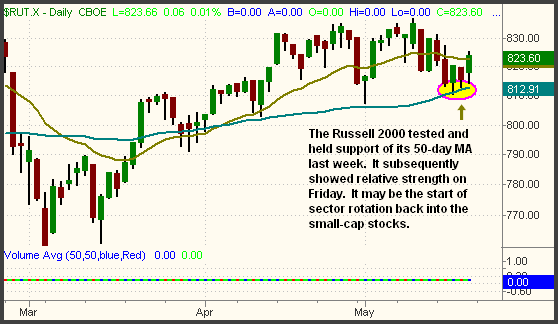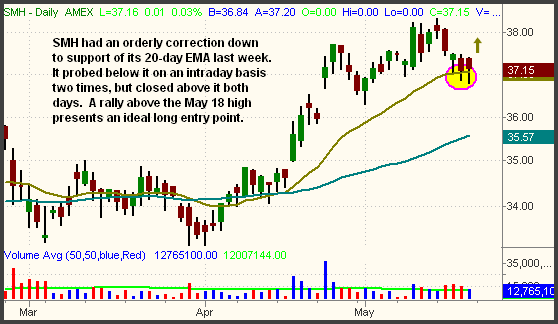| The Wagner Daily ETF Report for May 21 |
| By Deron Wagner |
Published
05/21/2007
|
Stocks
|
Unrated
|
|
|
|
The Wagner Daily ETF Report for May 21
Despite getting off to a shaky start earlier in the week, stocks concluded the week on a positive note. The major indices not only registered solid gains, but did so on higher volume as well. The Dow Jones Industrial Average gained 0.6%, the S&P 500 rallied 0.7%, and the Nasdaq Composite advanced 0.8%. The S&P Midcap 400 and small-cap Russell 2000 indices gained 0.6% and 1.0% respectively. Both the Russell 2000 and Nasdaq Composite showed leadership for a change, perhaps hinting at forthcoming sector rotation. Each of the key stock market indexes finished near their intraday highs.
After several days of higher volume selling in the Nasdaq, the markets showed welcome signs of accumulation last Friday. Total volume in the NYSE increased by 13%, as volume in the Nasdaq came in 3% above the previous day's level. The broad-based gains on increasing volume enabled both the S&P and Nasdaq to score bullish "accumulation days," the first such signs of institutional buying since May 9. Granted, monthly options expiration likely accounted for some of the higher turnover. Nevertheless, the accumulation helped to counteract the bearish price to volume ratios the market had flashed several times throughout the prior week. Advancing volume in the NYSE exceeded declining volume by a margin of nearly 3 to 1. The Nasdaq ratio was positive by 2 to 1.
The most notable factor of last Friday's session was the relative strength displayed by small-cap and tech stocks. For several weeks, the performance of both the Russell 2000 and Nasdaq Composite had lagged behind the S&P and Dow, registering smaller gains on the "up" days and larger losses on the "down" days. However, Friday's action showed a subtle shift that may have been the start of institutional sector rotation out of the Dow and S&P and back into the Nasdaq and Russell. Coinciding with Friday's relative strength is the fact that the Russell 2000 tested and held support of its 50-day moving average last week:

New long entries in small-cap stocks and ETFs such as the iShares Russell 2000 (IWM) now present a good risk/reward ratio, as long as the Russell 2000 holds above its 50-day MA. Presently, that key area of support is just below the 813 level. A firm close below the 50-day MA would obviously invalidate the initial signs of rotation into small-caps that we spotted last Friday.
One reason the Nasdaq may show relative strength in the coming week is the stabilization that has occurred in the Semiconductor HOLDR (SMH). After a four-week rally that begin in mid-April, SMH corrected throughout last week, but finished the week above support of its 20-day expontential moving average. As you can see on the daily chart below, SMH probed below its 20-day EMA on an intraday basis two times last week, but buyers stepped in to enable a closing price above the 20-day EMA both days:

A rally above last Friday's high would cause SMH to break out above its short-term hourly downtrend line that formed last week. Not only would such a move present a nice buying opportunity in SMH, but it could also have a positive impact on the overall performance of the Nasdaq. Although it's possible that last Friday's relative strength in the Russell and Nasdaq was just a fluke, we feel there is a good chance of continued buying interest in those sectors. When one area of the market begins to ascend too rapidly, such as the Dow has done over the past few months, institutions stealthily move money out of that area of the market and into another sector that offers a better risk/reward. Another day of outperformance in the Nasdaq and Russell would confirm our suspicions of institutional sector rotation into those indexes.
The S&P 500 closed the week just five points below its all-time closing high of 1,527. As such, it's almost a given that the index will test resistance of that closely-watched level in the coming days. We've been saying for weeks that the broad market is not likely to see a significant correction until the S&P first tests its record high. What happens after the inevitable run to the new high will be interesting. Will the S&P join the seemingly unstoppable Dow and keep marching to new heights, or will it instead provide a good excuse for institutions to lock in handsome gains on their positions? Only the passage of time will determine the outcome, but one should be prepared for a lot of volatility and erratic price action either way.
Deron Wagner is the Founder and Head Trader of both Morpheus Capital LP, a U.S. hedge fund, and Morpheus Trading Group, a trader education firm launched in 2001 that provides daily technical analysis of the leading ETFs and stocks. For a free trial to the full version of The Wagner Daily or to learn about Wagner's other services, visit MorpheusTrading.com or send an e-mail to deron@morpheustrading.com.
|